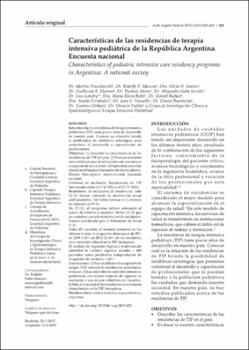| dc.contributor.author | Truszkowski, Martin. | |
| dc.contributor.author | Moreno, Rodolfo. | |
| dc.contributor.author | Santos, Silvia. | |
| dc.contributor.author | Moreno, Guillermo. | |
| dc.contributor.author | Lolster, Thomas. | |
| dc.contributor.author | Siaba Serrate, Alejandro. | |
| dc.contributor.author | Landrya, Luis. | |
| dc.date.accessioned | 2020-02-21T19:06:28Z | |
| dc.date.available | 2020-02-21T19:06:28Z | |
| dc.date.issued | 2015-10-01 | |
| dc.identifier.citation | Arch Argent Pediatr. 2015 Oct;113(5):425-32. | en_US |
| dc.identifier.issn | 0325-0075 | |
| dc.identifier.uri | https://riu.austral.edu.ar/handle/123456789/823 | |
| dc.description.abstract | INTRODUCTION:
Pediatric intensive care residency programs have been in place in Argentina for just a few years. Knowing their status offers the possibility to establish strategies to help with professional development and training.
OBJECTIVES:
1) To describe the characteristics of pediatric intensive care residency programs across Argentina. 2) To assess whether certain characteristics are related to a higher vacancy filling rate. 3) To assess job placement in the hospital where residents are trained.
DESIGN:
Descriptive, observational study. National survey.
INCLUSION CRITERIA:
Pediatric intensive care residency programs in place between April 1st, 2014 and May 31st, 2014.
RESULTS:
Thirty-one residency programs were analyzed. Only 11/31 had an annual hospitalization volume >400 patients. There were no guidelines and/or criteria for care in 9/31. The program suited the national reference framework in 17/31. There was no head of residents or resident trainer in 13/31. Only 5/31 had been certified by the Ministry of Health. There were 65 vacancies; this number increased in the past four years; vacancy filling rate decreased from 59% in 2009 to 30% in 2013. Sixty percent of residents got a job in the pediatric intensive care unit where they were trained. A multivariate logistic regression analysis identified the outcome measure annual hospitalization volume >400 patients as an independent predictor of vacancy filling rate >60%.
CONCLUSIONS:
1) Vacancy filling is deficient. 2) The number of certified residency programs is scarce. 3) Pediatric intensive care units with a higher number of hospitalizations were associated with a higher vacancy filling rate. 4) More than half of residents got a job in the pediatric intensive care unit where they were trained. | en_US |
| dc.language.iso | es | en_US |
| dc.publisher | Arch Argent Pediatr. | en_US |
| dc.subject | Intensive Care Units | en_US |
| dc.subject | Terapia intensiva pediátrica | en_US |
| dc.subject | Residencias | en_US |
| dc.subject | Argentina | en_US |
| dc.title | Características de las residencias de terapia intensiva pediátrica de la República Argentina. Encuesta nacional | en_US |
| dc.type | Article | en_US |


